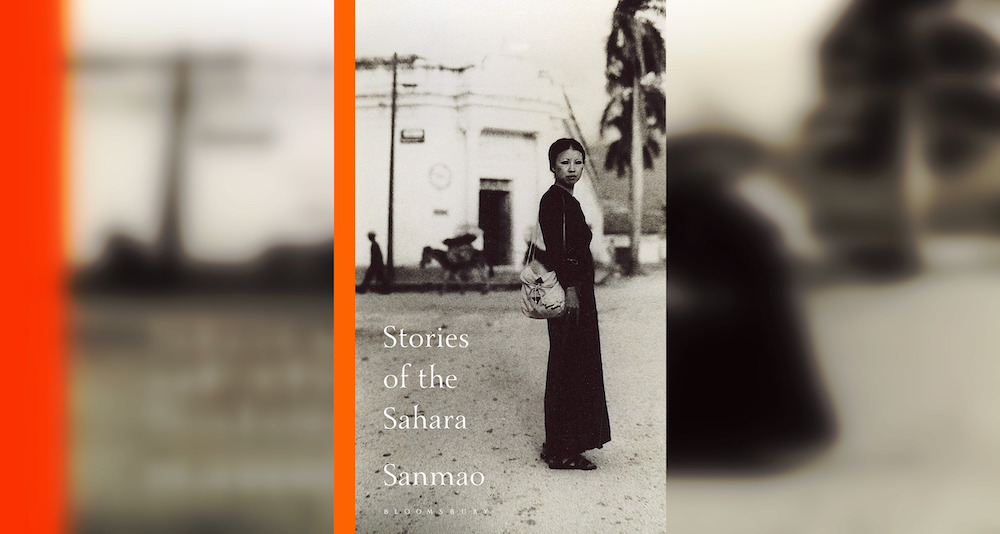Chen Maoping, known by her pen name Sanmao, was born in 1943 in Chongqing, China. A prolific writer and an ardent traveler, Sanmao lived in Taiwan, the Canary Islands, Central American, and Western Africa. Her life in countries abroad gave birth to over fourteen books, the most well-known of which, Stories of the Sahara, a hybrid of memoir and travelogue, catapulted her into the role of one of the most captivating and enigmatic writers at the time in the Chinese-speaking world.
Mike Fu’s translation of Stories of the Sahara, published in 2020 by Bloomsbury, marks the first time Sanmao’s writing is brought into the English-speaking world. In his conversation with Kimberly Y. Liu at Columbia Journal, he discusses the challenges of translating meaning and transposing language, dating a new translation of an older text, and what it means for a foreign writer to be less categorizable.
You mentioned in your translator’s note that you knew at once after reading Stories that you wanted to translate it. Can you elaborate a bit on what drew you so much and so immediately to Sanmao’s writing?
I grew up primarily in the States, so I wasn’t really exposed to Chinese literature until adulthood, out of personal interest. After graduate school, I gained some footing in this area, but reading Chinese is still something that takes a lot of energy and time for me. When I first encountered Sanmao, I was immediately captivated by her sensibilities that were so transnational and progressive for her time. I found her incredibly compelling, and was taken by how funny and relatable she was as a protagonist. Part of it was that her stories and her voice really struck me in an unexpected way, this Chinese woman writing in the ‘70s about her life in distant lands. Nowadays we don’t bat an eye at seeing Chinese people abroad, but she was doing this during a time when it was unprecedented, and in Africa no less. I also found it fascinating how she mediated the intercultural experience she had there: writing in Chinese while residing in a Spanish colony in Western Africa, and doing it with such self-awareness and humor. She embodied a cosmopolitan spirit in a way that was trail-blazing for women of her generation, and the confluence of all this resonated with me so strongly when I read the book for the first time as a twenty-something in New York.
Sanmao has been translated into various other Western languages, but you are the first to translate her into English. The anglophone market, in general, has proportionally a smaller amount of published translations, but do you have an idea of why such a canonical contemporary writer of the Chinese language has only just made it to anglophone readers?
From what I understand, there were Japanese and Korean translations of Stories of the Sahara published in the ‘80s, but her work never made it into any Western languages until 2016 or so, when the Spanish translation came out.
There are many factors involved here, but part of it may have to do with the appetite that English-language readers have for translated Chinese literature. Considering that only 3% of all books published in English every year are translated from other languages, the number of titles that make it into English is minuscule to begin with, although I think it’s improving. I feel that, broadly speaking, when it comes to Chinese books in translation, Western readers tend to be more interested in grand historical narratives from mainland Chinese writers, mostly men, or perhaps snapshots of hyper-contemporary Chinese urbanism, the like. I’d say that Sanmao represents a more marginal voice that doesn’t really fit into any of those paradigms. As a female writer from Taiwan, she’s an outlier in many ways. She defies easy categorization, and maybe this was part of the obstacle to her works getting translated earlier.
Part of what seemed to have made Sanmao’s voice so captivating and enduring even after all these years, as you put so well in your translator’s note, is the playful, conversational quality of it, how she speaks to us as if we were her friends. Can you shed some light on how you approached translating Chinese expressions and terms or Chinese-specific sentiments? (Two of my favorites are 乱拍乱打 luànpāi luàndǎ translated as willy-nilly, and 排外 páiwài as exclusive.)
There’s always a lot of room for interpretation when it comes to translating from any language, but particularly for a language like Chinese, there are many ways to slice it. I personally tried to strike a balance between preserving her cultural allusions and literary flair while making the work feel accessible overall and read naturally for Western readers. I think Sanmao wrote from the heart and her diction was a product of her upbringing and literary influences; she wrote with an audience in mind, that is, a Chinese readership that would easily understand her chengyu [Chinese idiomatic expressions] or references to Chinese poetry or history. For me, the task was to find the right words in English that would capture the spirit of what she was trying to say, sometimes in plainer English and sometimes a little more fluffy or poetic. Overall, I tried to conform my translated text to how I perceived her voice and spirit, and what she was trying to convey. A fair amount of my translation process entails research. There’s so much time you can spend parsing through a single phrase or statement, and it really gives you the opportunity to examine a particular expression or idiom from many different angles and think about how it can be represented in English.
It’s been forty years since the events of these stories took place in the ‘70s. Forty years isn’t exactly a long time, but with the internet, colloquial English has evolved so much, and you were also translating across two very different cultures. What was your approach regarding the modernity of the language you created? Did you make an effort to avoid recently-emerged expressions, or to specifically date the language to ‘70s-America for example, or ‘70s-Britain?
That’s a great question. Marigold Atkey, my editor at Bloomsbury, and I exchanged some thoughts about phrases I’d used that felt too contemporary. I wanted the work to be readable, but I didn’t want it to sound like it was written by someone from the contemporary world per se. Since the book was under contract with Bloomsbury UK, we did have to privilege Anglicisms (over colloquial American English) throughout the text. For example, in a scene about food spoiling, the phrase in the published version reads “the fish will go off,” whereas originally I had rendered it as “the fish will go bad.”
I guess you could say the translation dwells in a language that’s modern but preserves certain notes of mid-century British English which, in many ways, I think makes sense for the type of person that Sanmao was and for the time of her writing.
There are quite a lot of languages used here (Chinese, Spanish, and Arabic.) I found your decision to include Spanish phrases which in the original text were simply Chinese really effective, as it added to the vibrancy of the text and made good use of the common alphabet between English and Spanish that Chinese didn’t have. Could you talk about some of the decisions you navigated while working with the different languages?
I’m glad you enjoyed the Spanish. It felt natural to me that there should be some interjections in Spanish or Arabic, where appropriate, in the English translation. In the Chinese, she does transliterate Arabic phrases like salaam alaikum, among others. I felt like using Spanish phrases in my translation would be an easy way to remind the reader of the other cultural context for these stories. For example, the Hotel Nacional that appears several times in the book is rendered literally as guojia fandian (“national hotel”). After some reflection early on, it seemed fitting to use the Spanish name in my text, since this would’ve been a Spanish government-administered establishment. It was also quite fun to use some Spanish words or phrases that wouldn’t be lost in English, like Dios mío, señora, and so on. She’s married to a Spaniard, she’s speaking in Spanish all the time; she’s just communicating it in Chinese for her readers, so I thought, why not have a few things in Spanish here and there. It helps add dimension to the world that she lived in, which I felt was important.
You also speak French, and I was wondering how you find translating the Chinese language overall, if you could describe the linguistic gymnastics the act requires, especially compared to a language and culture relatively more similar to English, like French.
I think translation is a challenge between any two languages, and with Western languages there are certainly many different approaches to translating prose. But generally speaking, the structures are a bit more set already, the grammar and cadences transpose onto one another more easily. Between languages such as Chinese and English, ultimately there is a lot more breaking apart you have to do: reconfiguring different pieces of the text to fit them into what would make sense for an English-language reader. For this project, that happened a lot both on the sentence level and on the paragraph level. It was both fun and immensely challenging. During the editing process, I’d find myself coming to the same passage more than once and wanting to change it anew every single time. I ended up just having to let it go at a certain point, and learn how to stay satisfied with where I left it.
One of my favorite things to translate between Chinese and English is dialogue, because it can be both specific and vague at the same time. A phrase in Chinese can have many different connotations which lead to varying renditions in English. So when translating it into English, you really have to decide which would be the best interpretation for the sake of the reader. Chinese is so interesting, too, because there’s less reliance on subjects. We don’t really think about it as Chinese speakers, but it gives you pause when rendering dialogue in English.
How did, if at all, your experience as an editor for The Shanghai Literary Review inform your experience in translating this book?
They’ve definitely informed each other, my approach to editing other people’s work and my approach to being edited by others. The editing process was long but enjoyable. I was working with somebody who really dedicated a lot of time to parsing through text with me, sentence by sentence, word by word. Marigold doesn’t speak Chinese, but she was really able to ask the right questions to help me interrogate particular moments: about the intention, the diction, and other choices that I made. I think that process of asking questions, even if it ends up being something you ultimately decide not to change, can still be a fruitful dialogue between translator and editor; it helps you articulate a minor sentiment about the book and understand it a bit better.
It seems fortuitous that your book has come out at this specific time in our world, in which Sanmao’s openness and warmth and generosity still feel remarkable. What do you hope this translation accomplishes now that it’s out in the world?
I was just hoping that more people would have a chance to access her work, get to understand what a remarkable and funny character she was, and be won over by her charms. I think there’s already an audience for this kind of work, but I can see Sanmao surprising some readers, or going against certain preconceptions people might’ve had about Chinese women, particularly from a certain era. She was surprising for me to read for the first time, so I can imagine that for many Western folks, she might also break some stereotypes. For me, I was taken not so much by her living in Africa or traveling the world, but by the fact that she had really integrated herself into the community that she lived in, and was also multilingual; she was a cultural chameleon at a time when that sort of thing was very rare in the Chinese-speaking world.
I’m very happy to contribute to making Sanmao’s work more widely known. In the end, after so many rounds of edits, I had to just let it go. Translation is never going to be an exact science; I think what is out there right now is a snapshot in time of my interpretation of her work, in this particular day and age. All translations are so personal, as we bring our different cultural histories and relationships with language to the table. I’m sure this book would have read differently had it been translated decades ago, or if someone else were to translate it again in the future.
Are you working on anything now?
I’m working on some short story translations, and I’m trying to chip away at my novel manuscript. I’m quite interested in translating more of Sanmao’s work. The book she wrote immediately after Stories of the Sahara, about living in the Canary islands with José, has the same tone, the same irreverence and humor, minus the intensity of the political climate and violence that we see in Stories of the Sahara. I’d love to have a chance to work on this someday.
About the Translator
Mike Fu is a Chinese-English translator, editor, and writer. His translation of Stories of the Sahara by the late Taiwanese writer Sanmao was published by Bloomsbury in 2020 and has received critical acclaim from the Paris Review, the Asian Review of Books, the Christian Science Monitor, the TLS, Asymptote, and other venues. He is a co-founder and editor of The Shanghai Literary Review, as well as an editorial contributor to Heichi and Banana magazines. As a university administrator, he has worked in global academic programming at Columbia University and Parsons School of Design.
About the Author
Sanmao (1943–1991) was a Taiwanese writer and translator known for her memoirs and travelogues that drew from her life spent abroad. Stories of the Sahara, her most well-known collection of essays, has previously been translated into Japanese, Korean, Spanish, Catalan, and Dutch.
About the Interviewer
Kimberly Y. Liu is an MFA candidate in fiction at Columbia University and sits on the translation board of Columbia Journal, Issue 59.



